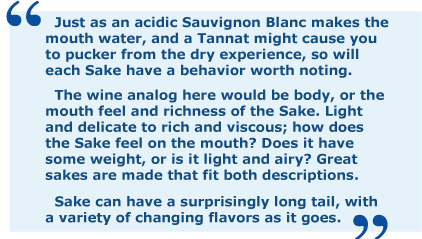|

Content Contributed by Jenny Parker and Anne Drummond, Imperial Beverage
We all have favorites. A rich, luscious, buttery Chardonnay on a hot, hot summer day, served outdoors under an ancient shade tree. A stinky, spicy, tongue drying Cabernet served with our favorite carnivorous treat. But Sake?
In the aftermath of the earthquake and tsunami in March 2011, not to mention a crisis of nuclear proportion, Japan’s Sake industry has taken a blow. With power outages rampant and little promise of revival imminent, many breweries are fearing the worst. Wine & Spirits (June, 2011) reports that from Tokyo to the west, however, breweries are operational, and exports will not cease to exist. (Kudos to W&S for ending the article thus: “...it might be a good time to familiarize yourself with a map of Japan.”)
ABOUT SAKE
Just as grape varietals impact the development of a wine, excellent Sake requires the finest rices. This grain contains a high starch content in its core, allowing the integrity of the rice to remain as long as possible through the brewing process. Called “Shinpaku-mai” in Japanese, the flavor profile of Sake depends on achieving balance between sweet and acid. This balance is trusted to skilled artisans that have understanding of climate, rice, water, technology, and the subtleties required in the touch of a brewing batch.
WHAT TO LOOK FOR IN A SAKE
FRAGRANCE
Whether a rich, rice scent, without distracting floral essence, or a perfumy sampling, fragrance is the first stop on the tasting spectrum, providing insight into the contents of your glass.
IMPACT
Is the Sake quiet on the palate, or explosive in the mouth? How does the liquid “behave” on the tongue? Just as an acidic Sauvignon Blanc makes the mouth water, and a Tannat might cause you to pucker from the dry experience, so will each Sake have a behavior worth noting.
 SWEET OR DRY SWEET OR DRY
Dimension of sweetness is often the most perceptible, yet most difficult to convey. The gravity of a Sake, which references the density of the Sake to the density of water, offers some suggestion to the viscosity and the sweetness. Regardless, the taster walks the subjective line of sweet to dry when tasting.
ACIDITY
Refreshingly simple, acidity is expressed on the tongue in Sake just as it would in high citric foods, offering a cutting through the oily measures of paired fishes, sauces or cheese.
PRESENCE
The wine analog here would be body, or the mouth feel and richness of the Sake. Light and delicate to rich and viscous; how does the Sake feel on the mouth? Does it have some weight, or is it light and airy? Great sakes are made that fit both descriptions.

EARTHINESS
A odd descriptor, perhaps, but many Sakes will provide a note of rusticity, with notes of mushroom or wet earth. This will add to the complexity or depth of the Sake, and is more common in Sake from the southern kurus. Aged Sake will also often feature this flavor note.
TAIL
The finish, the length, the persistence of the Sake. How long does it hang around? A well made Sake can have a surprisingly long tail, with a variety of changing flavors as it goes. Depending on mood or food, you may opt for something clean and bright, with a very short, brisk tail, or a Sake with something to savor after the last swallow.
HOW SAKE IS MADE
Sake is usually referred to in English-speaking countries as rice wine; however, this term is a misnomer. Unlike wine, in which alcohol is produced by fermenting sugar that is naturally present in grapes, sake is produced by means of a brewing process more like that of beer. Thus, sake is technically "rice beer" rather than "rice wine".
To make beer or sake, the sugar needed to produce alcohol must first be converted from starch.
The brewing process for sake differs from the process for beer, in that for beer, the conversion from starch to sugar and from sugar to alcohol occurs in two distinct steps. But when sake is brewed, these conversions occur simultaneously. Furthermore, the alcohol content differs between sake, wine, and beer. Wine generally contains 9%–16% ABV,[1] while most beer contains 3%–9%, and undiluted sake contains18%–20% (although this is often lowered to about 15% by diluting it with water prior to bottling). There are two basic types of sake: Futsū-shu (ordinary sake) and Tokutei meishō-shu (special-designation sake). Futsū-shu is the equivalent of table wine and accounts for the majority of sake produced. Tokutei meishō-shu refers to premium sakes distinguished by the degree to which the rice has been polished and the added percentage of brewer's alcohol or the absence of such additives.
PRODUCTION
The rice used for brewing sake is called shuzō kōtekimai (sake rice). The grain is larger, stronger, and contains less protein and lipid than the ordinary rice eaten by the Japanese. The rice has a starch component called shinpaku in the center of the grains. Since sake made from rice containing only starch has a superior taste, the rice is polished to remove the bran. If a grain is small or weak, it will break in the process of polishing. This rice is used only for making sake, because it is unpalatable for eating. There are at least 80 types of sake rice in Japan. Among these, Yamadanishiki, Gohyakumangoku, Miyamanishiki and Omachi rice are very popular.

|
